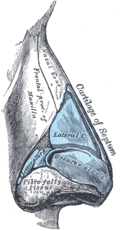Nasal bone
Nasal bone
The Nasal bone is one of the two small oblong bones varying in size and form in different individuals; they are placed side by side at the middle and upper part of the face and form, by their junction, "the bridge" of the nose. Each has two surfaces and four borders.
Structure
The nasal bone is an oblong bone which varies in size and form in different individuals. It is placed side by side at the middle and upper part of the face, and by their junction, forms "the bridge" of the nose. Each bone has two surfaces and four borders.
Surfaces
The outer surface is concave, and forms part of the nasal dorsum and the nasal cavity. The inner surface is concave and forms part of the nasal cavity.
Borders
The superior border, thick and uneven, articulates with the nasal notch of the frontal bone, and is marked by a groove for the passage of the nasal nerve. The inferior border is thin, and corresponds with the line of junction of the septum of the nose with the vomer. The lateral border is serrated for articulation with its fellow of the opposite side.
Clinical significance
Injury to the nasal bone can cause nasal fracture, which may lead to nasal deformity if not treated properly. Nasal bone fractures are the most common types of facial fractures, but they are relatively easy to treat due to the bone's accessibility.
Other animals
In many animals, the nasal bones contain the nasal cavity, which houses the olfactory bulbs.
See also
References
Transform your life with W8MD's budget GLP-1 injections from $125.
W8MD offers a medical weight loss program to lose weight in Philadelphia. Our physician-supervised medical weight loss provides:
- Most insurances accepted or discounted self-pay rates. We will obtain insurance prior authorizations if needed.
- Generic GLP1 weight loss injections from $125 for the starting dose.
- Also offer prescription weight loss medications including Phentermine, Qsymia, Diethylpropion, Contrave etc.
NYC weight loss doctor appointments
Start your NYC weight loss journey today at our NYC medical weight loss and Philadelphia medical weight loss clinics.
- Call 718-946-5500 to lose weight in NYC or for medical weight loss in Philadelphia 215-676-2334.
- Tags:NYC medical weight loss, Philadelphia lose weight Zepbound NYC, Budget GLP1 weight loss injections, Wegovy Philadelphia, Wegovy NYC, Philadelphia medical weight loss, Brookly weight loss and Wegovy NYC
|
WikiMD's Wellness Encyclopedia |
| Let Food Be Thy Medicine Medicine Thy Food - Hippocrates |
Medical Disclaimer: WikiMD is not a substitute for professional medical advice. The information on WikiMD is provided as an information resource only, may be incorrect, outdated or misleading, and is not to be used or relied on for any diagnostic or treatment purposes. Please consult your health care provider before making any healthcare decisions or for guidance about a specific medical condition. WikiMD expressly disclaims responsibility, and shall have no liability, for any damages, loss, injury, or liability whatsoever suffered as a result of your reliance on the information contained in this site. By visiting this site you agree to the foregoing terms and conditions, which may from time to time be changed or supplemented by WikiMD. If you do not agree to the foregoing terms and conditions, you should not enter or use this site. See full disclaimer.
Credits:Most images are courtesy of Wikimedia commons, and templates, categories Wikipedia, licensed under CC BY SA or similar.
Contributors: Prab R. Tumpati, MD


